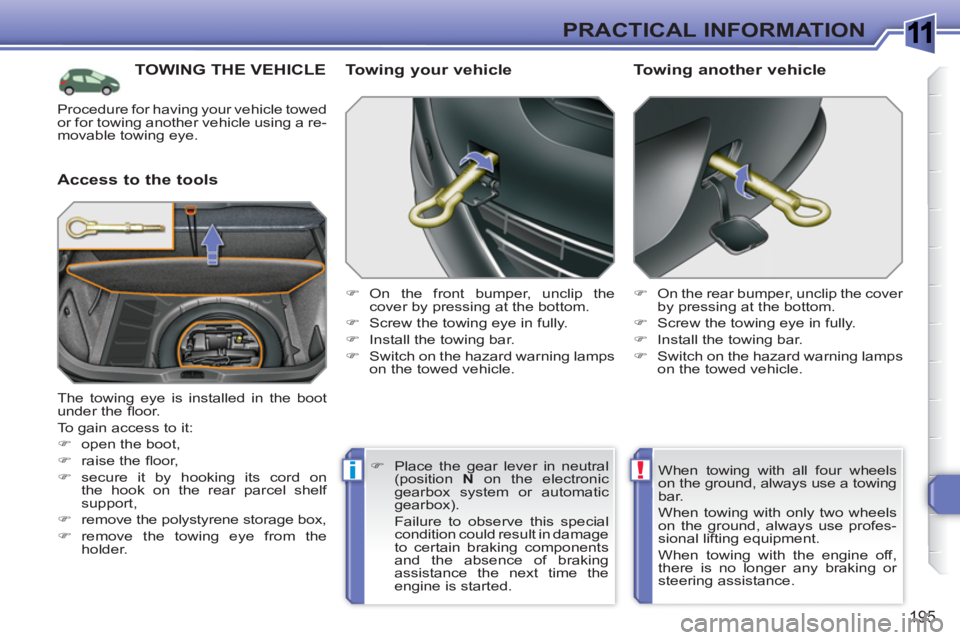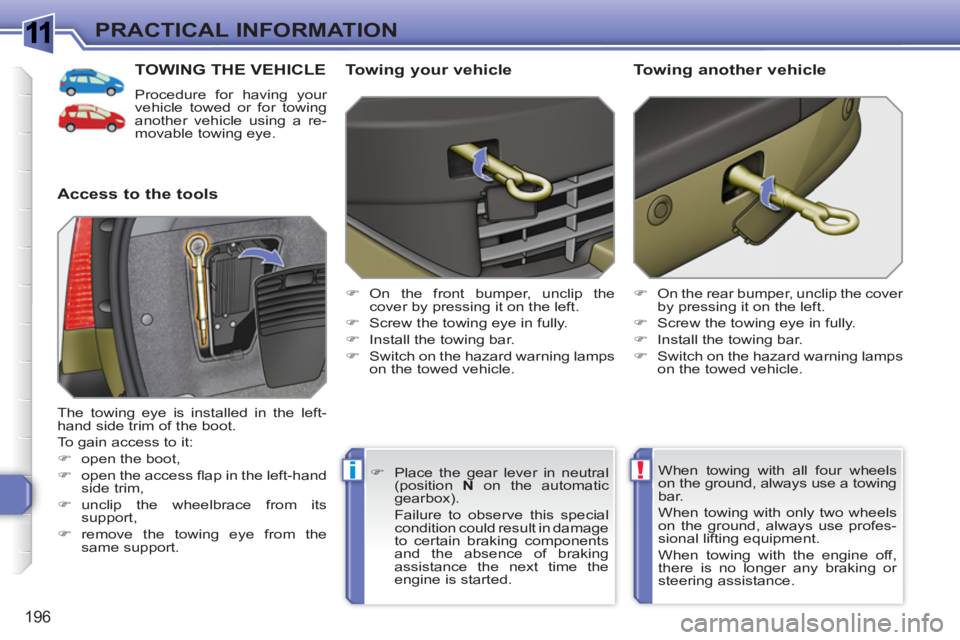Page 5 of 336

11
Direction indicators 128
Hazard warning lamps 128
Horn 128
Tyre under-infl ation detection 129
Emergency or assistance call 130
Braking assistance systems 130
Trajectory control systems 131
Front seat belts 132
Airbags 137�„
�„
�„
�„
�„
�„
�„
�„
�„
SAFETY 128 �Π140
Parking brake 141
Manual gearbox 141
Gear shift indicator 142
6-speed electronic gear
control gearbox 143
Automatic gearbox 147
Speed limiter 150
Cruise control 152
Parking sensors 154�„
�„
�„
�„
�„
�„
�„
�„
DRIVING 141 �Π155
Bonnet 157
Running out of fuel (Diesel) 158
Petrol engines 159
Diesel engines 160
Checking levels 161
Checks 162�„
�„
�„
�„
�„
�„
CHECKS
156 �Π163
Temporary puncture
repair kit 164
Changing a wheel 172
Changing a bulb 179
Changing a fuse 186
Battery 192
Energy economy mode 194
Changing a wiper blade 194
Towing the vehicle 195
Towing a trailer 197
Fitting roof bars 198
Very cold climate screen 199
Accessories 199�„
�„
�„
�„
�„
�„
�„
�„
�„
�„
�„
�„
PRACTICAL
INFORMATION 164 �Π200
Petrol and Biofl ex engines 201
Petrol and Biofl ex weights 205
Diesel engines 214
Diesel weights 217
Dimensions 226
Identifi cation markings 227�„
�„
�„
�„
�„
�„
TECHNICAL
DATA 201 �Π228
AUDIO EQUIPMENT
and TELEMATICS 229 �Π317
VISUAL
SEARCH 318 �Π324
ALPHABETICAL
INDEX 325 �Π329
Emergency or assistance 229
Peugeot Connect Media 233
Peugeot Connect Navigation 273
Peugeot Connect Sound 301�„
�„
�„
�„
Page 59 of 336

i
i
57
COMFORT
If after an extended stop in sun-
shine, the interior temperature is
very high, fi rst ventilate the pas-
senger compartment for a few mo-
ments.
Put the air fl ow control at a setting
high enough to quickly change the
air in the passenger compartment.
The air conditioning system does
not contain chlorine and does not
present any danger to the ozone
layer.
In order for these systems to be fully effective, follow the operation and main-
tenance guidelines below:
�)
To obtain an even air distribution, take care not to obstruct the exterior air
intake grilles located at the base of the windscreen, the nozzles, the vents
and the air outlets, as well as the air extractor located in the boot.
�)
Do not cover the sunshine sensor, located on the dashboard; this is used
for regulation of the digital air conditioning system.
�)
Operate the air conditioning system for at least 5 to 10 minutes, once or
twice a month to keep it in perfect working order.
�)
Ensure that the passenger compartment fi lter is in good condition and
have the fi lter elements replaced regularly (refer to the "Checks" section).
We recommend the use of a combined passenger compartment fi lter.
Thanks to its special active additive, it contributes to the purifi cation of
the air breathed by the occupants and the cleanliness of the passenger
compartment (reduction of allergic symptoms, bad odours and greasy
deposits).
�)
To ensure correct operation of the air conditioning system, you are also
advised to have it checked regularly as recommended in the Warranty and
Maintenance Record.
�)
If the system does not produce cold air, deactivate it and contact a
PEUGEOT dealer.
When towing the maximum load on a steep gradient in high temperatures,
switching off the air conditioning increases the available engine power and so
improves the towing ability.
The condensation created by the
air conditioning results in a dis-
charge of water under the vehicle
which is perfectly normal.
Page 111 of 336
109
FITTINGS
BOOT FITTINGS
1.
Rear parcel shelf
(see details on following page)
2.
Hooks
(see details on following page)
3.
Stowing rings
4.
Luggage retaining strap
5.
Enclosed storage tray
6.
Open storage tray
7.
Storage box
(see details on following page)
Page 113 of 336
111
FITTINGS
BOOT FITTINGS
1.
Rear parcel shelf
(see details on following page)
2.
12 V accessories socket
(see details on following page)
3.
Hooks
(see details on following page)
4.
Stowing rings
5.
Storage tray
6.
High load retaining net
(see details on following page)
7.
Luggage retaining strap
Page 116 of 336
FITTINGS
BOOT FITTINGS
1.
Load space cover
(see details on following page)
2.
Storage box
3.
12 V accessories socket
(see details on following page)
4.
Hooks
(see details on following page)
5.
Stowing rings
6.
High load retaining net
(see details on following page)
7.
Rear armrests with cup holder
8.
Luggage retaining strap
9.
Location for torch
(see details on following page)
Page 130 of 336

ii
128
SAFETY
DIRECTION INDICATORS
If you forget to cancel the direction in-
dicators for more than twenty seconds,
the volume of the audible signal will
increase if the speed is above 40 mph
(60 km/h).
�)
Left: lower the lighting stalk passing
the point of resistance.
�)
Right: raise the lighting stalk pass-
ing the point of resistance.
HAZARD WARNING LAMPS
A visual warning by means of the direc-
tion indicators to alert other road users to
a vehicle breakdown, towing or accident.
�)
Press this button, the direction indi-
cators fl ash.
They can operate with the ignition off.
Automatic operation of hazard
warning lamps
When braking in an emergency, de-
pending on the deceleration, the hazard
warning lamps come on automatically.
They switch off automatically the fi rst
time you accelerate.
�)
You can also switch them off by
pressing the button.
HORN
�)
Press one of the spokes of the steer-
ing wheel.
Use the horn moderately and only
in the following cases:
- immediate danger,
- overtaking a cyclist or pedes-
trian
- when approaching an area
where there is no visibility.
Audible warning to alert other road us-
ers to an imminent danger.
Page 197 of 336

1
!i
195
PRACTICAL INFORMATION
TOWING THE VEHICLE
Access to the tools
Towing your vehicle
�)
On the front bumper, unclip the
cover by pressing at the bottom.
�)
Screw the towing eye in fully.
�)
Install the towing bar.
�)
Switch on the hazard warning lamps
on the towed vehicle.
�)
On the rear bumper, unclip the cover
by pressing at the bottom.
�)
Screw the towing eye in fully.
�)
Install the towing bar.
�)
Switch on the hazard warning lamps
on the towed vehicle.
Towing another vehicle
The towing eye is installed in the boot
under the fl oor.
To gain access to it:
�)
open the boot,
�)
raise the fl oor,
�)
secure it by hooking its cord on
the hook on the rear parcel shelf
support,
�)
remove the polystyrene storage box,
�)
remove the towing eye from the
holder.
When towing with all four wheels
on the ground, always use a towing
bar.
When towing with only two wheels
on the ground, always use profes-
sional lifting equipment.
When towing with the engine off,
there is no longer any braking or
steering assistance.
�)
Place the gear lever in neutral
(position N
on the electronic
gearbox system or automatic
gearbox).
Failure to observe this special
condition could result in damage
to certain braking components
and the absence of braking
assistance the next time the
engine is started.
Procedure for having your vehicle towed
or for towing another vehicle using a re-
movable towing eye.
Page 198 of 336

1
!i
196
PRACTICAL INFORMATION
TOWING THE VEHICLE
Procedure for having your
vehicle towed or for towing
another vehicle using a re-
movable towing eye.
Access to the tools
Towing your vehicle
�)
On the front bumper, unclip the
cover by pressing it on the left.
�)
Screw the towing eye in fully.
�)
Install the towing bar.
�)
Switch on the hazard warning lamps
on the towed vehicle.
�)
On the rear bumper, unclip the cover
by pressing it on the left.
�)
Screw the towing eye in fully.
�)
Install the towing bar.
�)
Switch on the hazard warning lamps
on the towed vehicle.
Towing another vehicle
The towing eye is installed in the left-
hand side trim of the boot.
To gain access to it:
�)
open the boot,
�)
open the access fl ap in the left-hand
side trim,
�)
unclip the wheelbrace from its
support,
�)
remove the towing eye from the
same support.
When towing with all four wheels
on the ground, always use a towing
bar.
When towing with only two wheels
on the ground, always use profes-
sional lifting equipment.
When towing with the engine off,
there is no longer any braking or
steering assistance.
�)
Place the gear lever in neutral
(position N
on the automatic
gearbox).
Failure to observe this special
condition could result in damage
to certain braking components
and the absence of braking
assistance the next time the
engine is started.